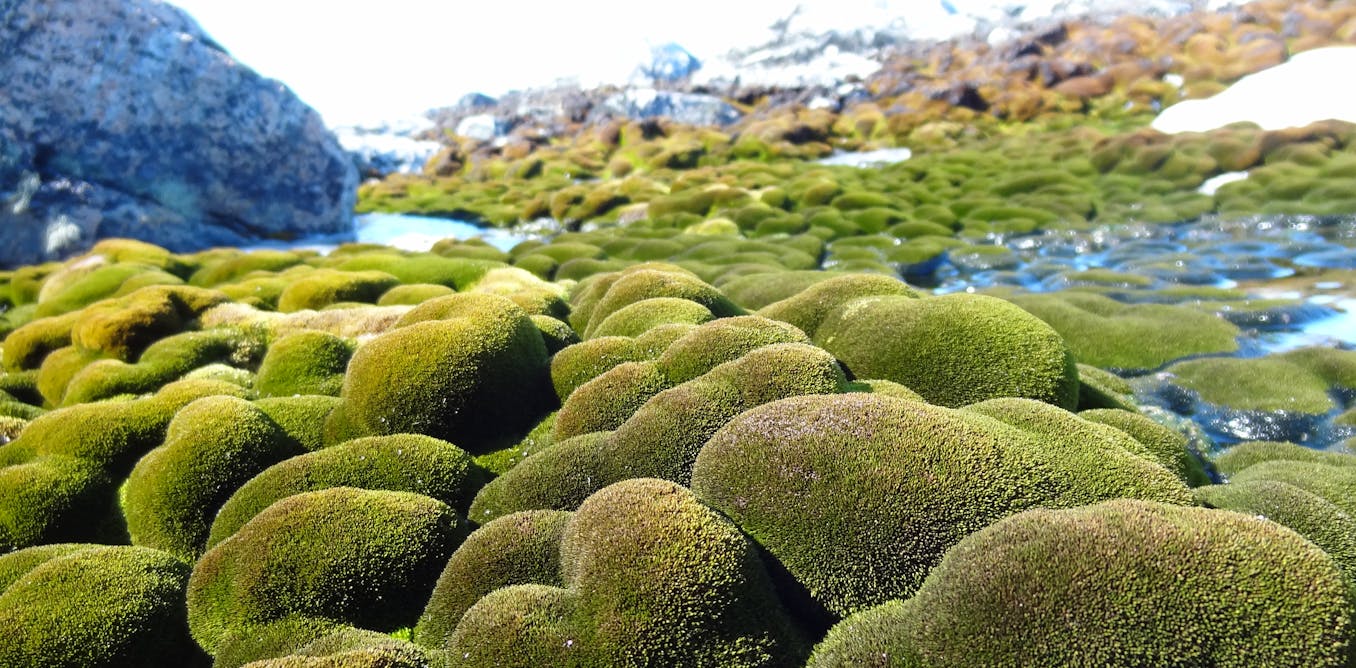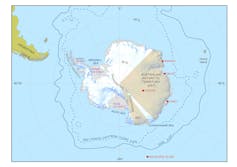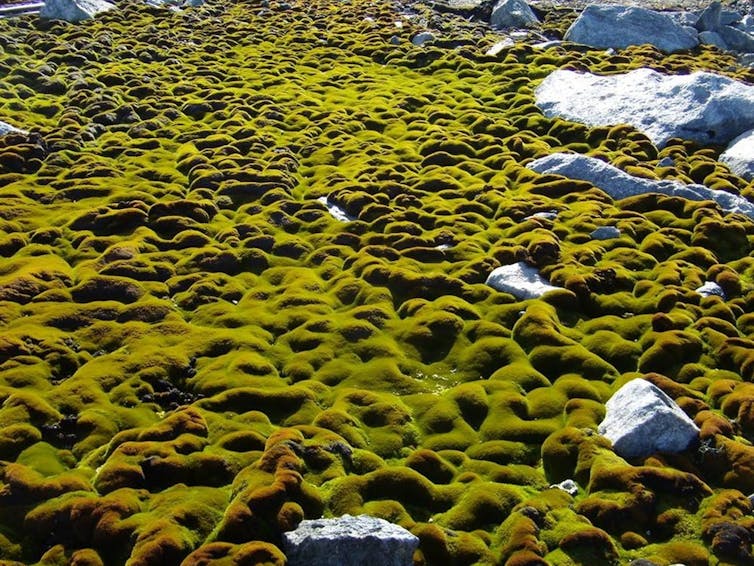A
study points to OZONE DEPLETION in addition to climate change on the
Southern Ocean


In the last day or so a new paper from Nature has identified ozone depletion as a secondary cause of warming of the southern ocean as well as some other factors.
Look up the hole in the ozone layer in Antarctica in Google and you will find a plethora of articles saying the hole in the ozone layer is "healing".
Margo has been chronicling ozone levels in Antarctica and found extremely low levels which appear (if yesterday's figures are anyhting to go by) to be getting worse despite the fact that the sun is returning to the continent.


In the last day or so a new paper from Nature has identified ozone depletion as a secondary cause of warming of the southern ocean as well as some other factors.
What’s
Causing Antarctica’s Ocean to Heat Up? New Study Points to 2 Human
Sources
With help
from floating data-collectors, a new study reveals the impact
greenhouse gas emissions and ozone depletion are having on the
Southern Ocean.
26
November, 2014
The
Southern Ocean around Antarctica is warming at an alarming rate—twice
that of the rest of the world's oceans. Now, researchers have
developed more powerful evidence pointing to the human causes.
Though
warming had been observed in the past, there was little historical
data to allow scientists to pinpoint the causes with much certainty.
In
a new study, researchers used climate models, the past observations
that did exist and data flowing in from new ocean-going sensors to
show how greenhouse gas emissions and the depletion of ozone in the
atmosphere have led to both a warming of the Southern Ocean and an
increase in its freshwater content. The findings also rule out
natural variability as a major source of those changes.
"The
observed warming is due to human influence," said oceanographer
Neil Swart, a research scientist with Environment and Climate Change
Canada who led the study, published
Monday in
the journal Nature
Geoscience.
"That may have been suspected or proposed before, but this is
the evidence that really proves it."
Ocean-Going Floats and Climate Models
The
Southern Ocean is notoriously inhospitable, clogged with ice and home
to rough seas and weather. As a result, there weren't many
measurements in the past.
In
2004, a partnership of 30 countries across the world launched the
Argo program to improve what's known about the world's oceans, and
now there are close to 4,000 programmable floats collecting data in
the oceans worldwide. That is helping improve what's known, but the
lack of complete data going back decades has, in the past, left
researchers wondering if their conclusions were robust.
or
this study, Swart and his colleagues used data collected in the
Southern Ocean from 1950 onward, which showed the pattern of warming
and freshening. Then they turned to computer models to try to
replicate the cause.
"We
sampled the model just the way the ships sampled the ocean so we
could compare them," explained Sarah Gille, a physical
oceanographer at Scripps Institution of Oceanography and a co-author
of the paper.
So
if a ship had taken a sample at a specific latitude and longitude on
a certain date, the researchers could sample the model at the same
location during the same month and year. Within the model, they were
then able to turn off and on different influences, like natural
variability (from solar radiation and volcanoes), the emissions of
aerosols, greenhouse gas emissions and ozone depletion.
When
they looked at natural variability and aerosol emissions, neither
affected warming or freshening enough to explain what had been
observed. But greenhouse gas emissions and ozone depletion did.
Because
of global action under the Montreal Protocol, through which the world
in 1987 committed to stop producing ozone-depleting
substances that
had been used in such products as refrigerants and aerosol sprays,
it's expected that the role of ozone depletion will shrink. "That
action—the Montreal Protocol—is often put forward as an example
of, "Hey, as a society we can tackle these problems as they come
up," Swart said.
The
role that ozone depletion is playing in warming the Southern Ocean is
far less than the role of greenhouse gas emissions, though, and so
far, those emissions have been a stickier problem to fix.
"That
signal of greenhouse gas emissions is just going to continue on
intensifying as long as we keep emitting more and more," Swart
said.
What's Causing the Freshwater Increase?
The
study also suggested that most of the increasing freshwater content
in the oceans is coming from precipitation, rather than melting ice
from Antarctica.
Cecilia
Bitz, a sea ice and climate scientists at the University of
Washington who was not involved in the study, said she found the
study's observations about the increased freshening particularly
interesting. "According to their study, an increase in runoff of
meltwater from Antarctica is not needed to explain the decrease in
salinity in the upper ocean when considering the linear changes over
the last 70 years," she said.
In
the future, Gille said, the role that glacial melt is playing in the
freshening of the Southern Ocean is "one of the enormous
questions that the research community would like to address."
What Warmer Water Could Mean for the Ice
Another
study published last week in Nature offers
more insight into the future of East Antarctica's massive ice sheet.
David
Wilson, a geochemist at Imperial College London, and his co-authors
found that even 2 degree Celsius of warming above pre-industrial
times had been enough to melt a significant part of the East
Antarctic Ice Sheet in the past.
During
the Pleistocene era, roughly 125,000 years ago, sea levels were as
much as 20 to 30 feet higher than they are now. Wilson and his
co-authors focused on the Wilkes Subglacial Basin and how it
responded to warming then. Unlike the land-based glaciers, the Wilkes
Subglacial Basin is built up from the ocean floor, which can make it
particularly susceptible to warming waters. Their findings suggested
that 2°C warming now, if sustained over a couple of millennia, could
begin melting that location.
"If
we wish to avoid the worst consequences—and you can think, this can
have effects on coastal regions, agriculture, island nations—clearly
we need to make efforts to change our behavior patterns and
decarbonize the economy," Wilson said. "This is clearly
what it's pointing towards."
Antarctica’s
‘moss forests’ are drying and dying
With help
from floating data-collectors, a new study reveals the impact
greenhouse gas emissions and ozone depletion are having on the
Southern Ocean.

The
lush moss beds that grow near East Antarctica’s coast are among the
only plants that can withstand life on the frozen continent. But our
new research shows that these slow-growing plants are changing at a
far faster rate than anticipated.
We
began monitoring plant ecosystems 18 years ago, near Australia’s
Casey Station in the Windmill Islands, East Antarctica.
Casey Station
is on East Antarctica’s coast. Click map to zoom. Australian
Antarctic Data Centre
As
we report
in Nature Climate Change today,
within just 13 years we observed significant changes in the
composition and health of these moss beds, due to the drying effects
of weather changes prompted by damage to the ozone layer.
Living on the edge
Visitors
to Antarctica expect to see a stark landscape of white and blue: ice,
water, and sky. But in some places summer brings a surprisingly
verdant green, as lush mosses emerge from under their winter snow
blanket.
Because
it contains the best moss beds on continental Antarctica, Casey
Station is dubbed the Daintree
of the Antarctic.
Individual plants have been growing here for at least 100 years;
fertilised by ancient
penguin poo
Antarctic
mosses are extremophiles, the only plants that can survive the
continent’s frigid winters. They live in a frozen desert where
life-sustaining water is mostly locked up as ice, and they grow at a
glacial pace – typically just 1 mm a year.
These
mosses are home to tardigrades and
other organisms, all of which survive harsh conditions by drying out
and becoming dormant. When meltwater is available, mosses soak it up
like a sponge and spring back to life.
The
short summer growing season runs from December to March. Day
temperatures finally rise above freezing, providing water from
melting snow. Overnight temperatures drop below zero and mosses
refreeze. Harsh, drying winds reach speeds of 200 km per hour. This
is life on the edge.
Tough turf
When
we first began monitoring the moss beds, they were dominated
by Schistidium
antarctici,
a species found only in Antarctica. These areas were typically
submerged through most of the summer, favouring the water-loving
Schistidium. But as the area dries, two hardy, global species have
encroached on Schistidium’s turf.
Like
tree rings, mosses preserve a record of past climate in their shoots.
From this we found nearly half of the mosses showed evidence of
drying.
Healthy
green moss has turned red or grey, indicating that plants are under
stress and dying. This is due to the area drying because of colder
summers and stronger winds. This increased desertification of East
Antarctica is caused by both climate change and ozone
depletion.
class="caption"
style="margin: 0px; padding: 0px; border: 0px; outline: 0px;
font-size: 11px; vertical-align: baseline; background:
transparent;"Moss beds,
with moss in the foreground showing signs of stress. Sharon
Robinson, Author provided
Since
the 1970s, man-made substances have thinned Earth’s protective
sunscreen, the ozone layer, creating a hole that appears directly
over Antarctica during the southern spring (September–November).
This has dramatically
affected the southern hemisphere’s climate.
Westerly winds have moved closer to Antarctica and strengthened,
shielding much of continental East Antarctica from global warming.
Our
study shows that these effects are contributing to drying of East
Antarctica, which is in turn altering plant communities and affecting
the health of some native plant species. East Antarctica’s mosses
can be viewed as sentinels for a rapidly drying coastal climate.
But
there is good news. The ozone layer is slowly recovering as
pollutants are phased out thanks to the 1987
Montreal Protocol.
What is likely to happen to Antarctic coastal climates when ozone
levels recover fully by the middle of this century?
Antarctic
ice-free areas are currently less than 1% of the continent but
are predicted
to expand over the coming century.
Our research suggests that this may isolate moss beds from snow
banks, which are their water reservoirs. Ironically, increased ice
melt may be bad news for some Antarctic mosses.
East
Antarctica is drying – first at the hands of ozone depletion, and
then by climate change. How its native mosses fare in the future
depends on how we control greenhouse gas emissions. But with decisive
action and continued monitoring, we can hopefully preserve these
fascinating ecosystems for the future.






No comments:
Post a Comment
Note: only a member of this blog may post a comment.